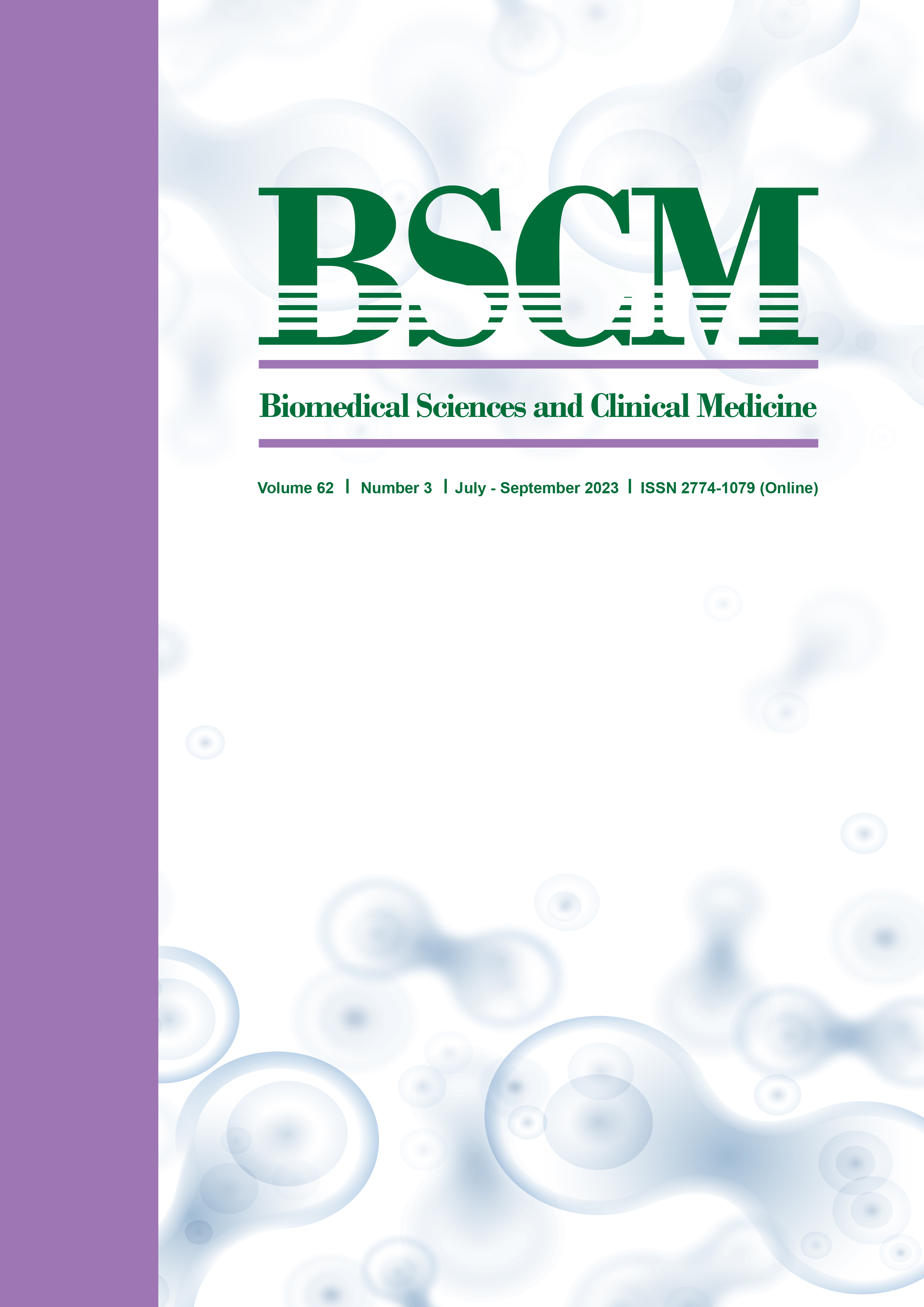Incidence, Risk Factors, and Clinical Outcomes of Reintubation Following Planned Extubation in a Postanesthetic Care Unit: A Case-control Study
Main Article Content
Abstract
Objective This study aimed to determine the incidence, risk factors, and clinical outcomes associated with reintubation after a planned extubation (RAP) during the postoperative period.
Methods A retrospective case-control study was conducted on patients with RAP in an operating theater or postanesthetic care unit. Forty-six cases between 2013 and 2017 were extracted from the anesthetic database of the Department of Anesthesiology, Faculty of Medicine, Chiang Mai University. Cases with RAP were randomly matched in a ratio of 1:4 with selected controls. Univariable and multivariable logistic regression were used for the analysis and results are presented as the odds ratio (OR) and 95% confidence interval (CI).
Results A total of 230 patients (46 cases and 184 controls) were included. The independent risk factors of RAP included creatinine clearance (CrCl) 25-60 mL/min (OR = 3.34; 95% CI: 1.83-9.46), CrCl < 25 mL/min (OR = 4.26; 95% CI: 1.04-17.47), preoperative oxygen saturation ≤ 94% (OR = 16.78; 95% CI 3.99-70.57), and use of aminosteroid muscle relaxants (OR = 3.00; 95% CI: 1.23-7.31). The immediate outcomes of RAP were unplanned ICU admission (65.22%), major respiratory events (19.57%), and cardiovascular events (19.57%).
Conclusions Independent risk factors of RAP were renal insufficiency, CrCl < 60 mL/min, preoperative oxygen saturation ≤ 94%, creatinine clearance 25-60 mL/min, and use of an aminosteroid muscle relaxant. Proper evaluation and management before extubation could help prevent the occurrence of RAP.
Article Details

This work is licensed under a Creative Commons Attribution 4.0 International License.
References
Chinachoti T, Chau-in W, Suraseranivongse S, Kitsampanwong W, Kongrit P. Postoperative reintubation after planned extubation in Thai Anesthesia Incidents Study (THAI Study). J Med Assoc Thai. 2005;88(Suppl 7):S84-94.
Mort TC. Unplanned tracheal extubation outside the operating room: a quality improvement audit of hemodynamic and tracheal airway complications associated with emergency tracheal reintubation. Anesth Analg. 1998;86:1171-6.
Rujirojindakul P, Geater A, McNeil E, Vasinanukorn P, Prathep S, Asim W, et al. Risk factors for reintubation in the post-anaesthetic care unit: a case-control study. British journal of anaesthesia. 2012;109:636-42.
Rujirojindakul P, Ua-kritdathikarn T, Wanasuwannakul T, Loetwiriyakul W. Reintubation in the recovery room, Songklanagarind Hospital: incidence, causes and complication. Thai J Anesthesiol. 2006;32:279-84.
Charuluxananan S, Sriraj W, Punjasawadwong Y, Pitimana-Aree S, Lekprasert V, Werawatganon T, et al. Perioperative and Anesthetic Adverse events in Thailand (PAAd Thai) incident reporting study: anesthetic profiles and outcomes. Asian Biomedicine. 2017;11:21-32.
Dupont H, Le Port Y, Paugam-Burtz C, Mantz J, Desmonts M. Reintubation after planned extubation in surgical ICU patients: a case-control study. Intensive Care Med. 2001;27:1875-80.
Saugel B, Rakette P, Hapfelmeier A, Schultheiss C, Phillip V, Thies P, et al. Prediction of extubation failure in medical intensive care unit patients. J Crit Care. 2012;27:571-7.
De la Garza Ramos R, Passias PG, Schwab F, Bydon A, Lafage V, Sciubba DM. Incidence, risk factors, and mortality of reintubation in adult spinal deformity surgery. Clin Spine Surg. 2017;30:E896- E900.
Chinachoti T, Poopipatpab S, Buranatrevedhya S, Taratarnkoolwatana K, Werawataganon T, Jantorn P. The Thai Anesthesia Incident Monitoring Study (Thai AIMS) of post anesthetic reintubation: an analysis of 184 incident reports. J Med Assoc Thai. 2008;91:1706-13.
Bunchungmongkol N, Pipanmekaporn T, Punjasawadwong Y, Cenpakdee S. Reintubation in the postanesthesia care unit: A retrospective study of 21,349 cases at Chiang Mai University Hospital, Thailand. Chiang Mai Medical Journal. 2009;48: 49-55.
Liu C-C, Shih H-C, Lin S-H, Lu C-Y. Postoperative reintubation at a postanesthesia care unit from 2010 to 2011 at a teaching hospital in Taiwan. E-Da Medical Journal. 2015;2:38-42.
Uppan K, Jeerararuensak W, Chau-In W, Chairatana L, Promkhote P. Anesthesia Related to Reintubation after Planned Extubation Within 24 Hours after General Anesthesia in Srinagarind Hospital: Incidence and Risk Factors. Srinagarind Medical Journal. 2011;26:325-32.
Chen S, Zhang Y, Che L, Shen L, Huang Y. Risk factors for unplanned reintubation caused by acute airway compromise after general anesthesia: a case-control study. BMC Anesthesiol. 2021; 21:1-8.
West JB, Luks AM. West’s Respiratory Physiology. Lippincott Williams & Wilkins; 2020.
McKeage K, Perry CM. Propofol a review of its use in intensive care sedation of adults. CNS Drugs. 2003; 17:235-72.
Singh PM, Borle A, McGavin J, Trikha A, Sinha A. Comparison of the recovery profile between desflurane and sevoflurane in patients undergoing bariatric surgery-a meta-analysis of randomized controlled trials. Obes Surg. 2017;27:3031-9.
Acheampong D, Guerrier S, Lavarias V, Pechman D, Mills C, Inabnet W, et al. Unplanned postoperative reintubation following general and vascular surgical procedures: outcomes and risk factors. Ann Med Surg (Lond). 2018;33:40-3.
Lin H-T, Ting P-C, Chang W-Y, Yang M-w, Chang C-J, Chou A-H. Predictive risk index and prognosis of postoperative reintubation after planned extubation during general anesthesia: a single-center retrospective case-controlled study in Taiwan from 2005 to 2009. Acta Anaesthesiol Taiwa. 2013; 51:3-9.
Tillquist MN, Gabriel RA, Dutton RP, Urman RD. Incidence and risk factors for early postoperative reintubations. J Clin Anesth. 2016;31:80-9
Wu C-Y, Wu K-L, Wu T-S, Tseng W-C, Lin B-F, Lai H-C. The relationship between the sugammadex use and postoperative reintubation in the absence of neuromuscular monitoring. J Med Sci. 2022;42: 214-20.
McAlister FA, Bertsch K, Man J, Bradley J, Jacka M. Incidence of and risk factors for pulmonary complications after nonthoracic surgery. Am J Respir Crit Care Med. 2005;171:514-7.
Milledge J, Nunn J. Criteria of fitness for anaesthesia in patients with chronic obstructive lung disease. Br Med J. 1975;3(5985):670-3.
Karcz M, Papadakos PJ. Respiratory complications in the postanesthesia care unit: A review of pathophysiological mechanisms. Can J Respir Ther. 2013; 49:21-9.
Aragón-Benedí C, Pascual-Bellosta A, Ortega-Lucea S, Visiedo-Sánchez S, Martínez-Ubieto J. Predictive study of pharmacological reversal for residual neuromuscular blockade and postoperative pulmonary complications: a prospective, observational, cohort study. Sci Rep. 2022;12:14955.
Cammu G. Residual neuromuscular blockade and postoperative pulmonary complications: what does the recent evidence demonstrate? Curr Anesthesiol Rep. 2020;10:131-6.
Murphy GS, Brull SJ. Quantitative neuromuscular monitoring and postoperative outcomes: a narrative review. Anesthesiology. 2022;136:345-61.


